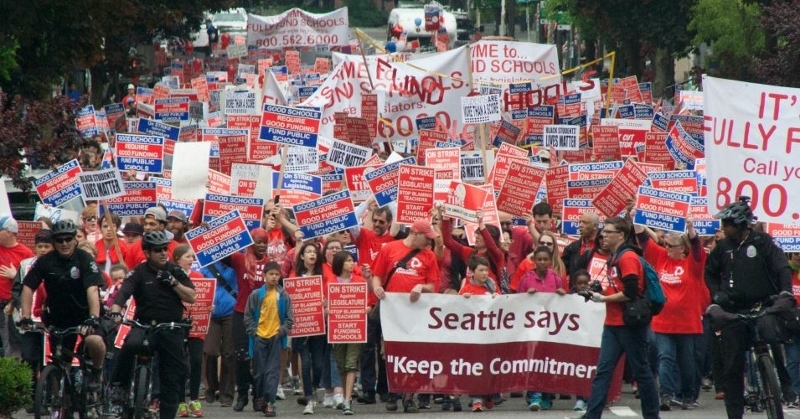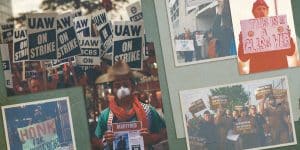Photo credit: http://www.commondreams.org/news/2015/09/11/wont-back-down-seattle-teacher-strike-continues-third-day
All over the United States, it’s back-to-school time. For teachers in Seattle, Washington, however, the season this year does not mean days filled with memorizing new students’ names and faces, setting ground rules, and beginning to build classroom cultures of community and respect. It means standing on the picket line. On September 9, 2,000 teachers from the Seattle Education Association (SEA) voted to go on strike. This is the first teachers’ strike in Seattle in 30 years, and it was decided unanimously—not a single teacher voted against the strike.
What is the Strike About?
The Seattle school district is made up of 5,000 teachers and 100 public schools. The strike affects 53,000 students. This strike is partly about a pay raise, but also about a slew of other issues that affect teachers, students, and families.
A pay raise for teachers is certainly one of the demands being fought for in Seattle. According to Forbes, the cost of living in Seattle, among the highest in nation , is 21.3% above the national average and continues to rise. Despite this, Seattle teachers have not received a raise in six years. The school district has proposed an 8.2% pay raise over three years, as well as adding a half hour to every school day (in addition to all of the unpaid work teachers do after school and on weekends). The teachers’ union wants a 6% wage increase each year of the contract, in part to make up for the lack of pay increases for the past 6 years.
The union points to the fact that the Seattle economy is doing very well, with Forbes ranking it sixth in its list of best places for business and careers . Additionally, the state Supreme Court recently ruled the the state was failing to fund public schools adequately, forcing it to increase funding to public schools. .
Although the question of wages alone is a strong enough reason for workers to mobilize, the problems in the public education system of Seattle (and the nation) demand that teachers mobilize for more than pay raise, which is exactly what Seattle teachers are doing. The union has taken a leading role in denouncing racism within schools, pointing to disproportionate disciplining of Black children, especially boys. Black children get suspended at 4 times the rate of white children, according to a recent study of Seattle schools . This hyper-disciplining of Black youth begins as young as kindergarten, a problem which even brought on a federal investigation in 2013 . The union has proposed “race and equity teams” at every school in the district, which would identify inequalities and make specific recommendations to address them. In this way, the strike is both a lever for the dignity of working teachers and a weapon against systemic racism.
Another issue teachers have mobilized for is a minimum of 30 minutes of recess for elementary school students. It may seems obvious that being in a classroom for hours on end is exhausting for children (especially under the age of 11) who need time outside to socialize and play. In some schools serving poor and working-class students of color, however, recess has been [as short as 15 minutes. -> http://www.seattletimes.com/opinion/guest-schools-need-to-learn-the-importance-of-recess/) After only a few days of the strike, the Public School District has already conceded this demand, mandating 30 minutes of recess in all elementary schools.
The teacher’s strike is also targeting standardized testing. With the spike in testing brought about by the No Child Left Behind Act, the trend towards an increase in testing leaves less room for instruction and creative curricula. The list of standardized tests students take per year begins as early as kindergarten and is extensive, with 8th graders taking nine tests during the year . Today, Seattle Public school students take an average of 60 standardized tests from elementary through high school, or about five standardized tests per school year. Each of these tests takes several days to administer, taking up valuable school time. As a solution, the union proposes a joint committee of the SEA (Seattle Educators Association) and the public school district. This joint committee would accept or reject any standardized test beyond the federally-mandated ones. It would also put an end to “Student Growth Rating” which ties teacher evaluation to student exam scores.
The union’s final demand is that the district hire more school counselors and psychologists. In schools with large numbers of students of color—the most under-funded schools—counselors and psychologists are expected to serve hundreds of students, a task that is impossible to do well. As Seattle public school teacher Jesse Hagopian writes in his blog , “At many schools, including Garfield High School where I teach, counselors have hundreds of students on their caseloads and can’t possibly provide them all the social and emotional supports they need. At my son’s elementary school this year, the principal had to stop all spending on school supplies like paper and pencils in order to use those funds to save our counselor position.”
Race, Class and Cuts: The gutting of public schools
This strike takes place in the world of public education after two key pieces of federal education legislation: No Child Left Behind (NCLB), put forth by the George W. Bush administration, and Race to the Top, a program of the Obama administration. NCLB required testing and tied federal funding to testing outcomes, in addition to taking steps to privatize the education system by opening doors to privately-funded tutoring and other aspects of schooling. The excessive testing children in Seattle undergo is a direct consequence of the initiatives “pioneered” by NCLB. Race to the Top, the initiative put forth by the Obama administration, furthered the privatization and excessive testing of schools.
Racial disparities are the backdrop of the American public school system, with an overwhelming number of students of color attending schools with less funding, less resources and more critical problems than those faced by white students. In Seattle, the public school system is overwhelmingly segregated. Fifty-eight percent of students enrolled in the Seattle public school district are white, but many of the white students are concentrated in a small number of schools. About one third of the schools in the district have much higher numbers of white students than the district-wide 58%. In a district with 42% students of color, 20 out of the 100 hundred schools have only 10% non-white students .
The segregation in schools is matched by segregation in resources and educational opportunities. Black students score about 30% lower in math than the district average and about 20% lower in reading.
The strike also comes amidst years of cutting funds for public schools on the federal, as well as the state level. In fact, the Seattle Supreme Court had to force the state to allocate more funds to public education. In 2012, the Supreme Court of Washington State ruled that the state was not adequately funding schools and ordered legislators to provide for the costs of basic education. In May of 2015, the state legislature had not made progress in funding schools, so the 65 districts in the state took part in a one-day work stoppage. In August, the court found the state legislature in contempt of court and ordered a fine of $100,000 per day until they funded k-12 education, leading to new monies being introduced to the education budget .
The Obama administration also cut education spending for most of his Presidency and only minimally increased funds this year. According to a US News report, education spending has decreased consistently in the past five years and it was cut five times more than all other spending during the Obama administration.
The Seattle Education Association and the Steps to the Strike
The Seattle teachers’ union has been discussing the problems with the public school system for years prior to this strike. Particularly, there is a group within the union called “Social Equality Educators” who call for a member-driven union against the corporate reform agenda of public education, full funding equity across districts, and culturally relevant education. Furthermore, parents in the district have become politically active, forming a group called “Lunch and Recess Matter,” with which the union has organized in the past.
Seattle teachers are no strangers to political statements and political organizing. In 2013, Garfield High School teachers gained national attention when they organized to refuse a district-mandated standardized test . In May 2015, teachers went on a one-day work stoppage to increase funding for public schools.
Furthermore, two smaller teachers strikes have occurred just this month. In early September, 90 teachers from South Whidbey Educational Association had a five-day work stoppage, which shut down schools in Whidbey, a town north of Seattle. On Monday, these teachers ratified a new contract, ending the work stoppage taking place just north of Seattle. In Pasco, Washington, teachers were also on strike, defying the Franklin County judge’s injunction to end the strike. Their strike ended on Monday, September 14.
And in September, the teachers of the Seattle public school district voted to go on strike after negotiations with the school district over the summer led nowhere. In fact, only recently did the district bother to offer counter proposals, after initially rejecting all of the union’s proposals .
Seattle Teachers on Strike United with Families and Communities
The teachers have organized pickets every school day, standing in front of their schools with signs that say “United for Great Seattle Schools,” “Black Lives Matter,” “I <3 My Students,” and “Fair Contract Now.” However, teachers have made sure to have a dialogue with the community and show their goodwill. On September 11, teachers left the picket lines to engage in a day of service by volunteering at local nonprofits. Families and community members have come out to support teachers. Families often brought food to teachers on the picket line; some even organized a “Soup for Teachers” facebook page to bring them food and encouragement. Some community businesses have offered free food and drinks to teachers on the picket line as well, expressing their support for the strike .
The Need to Question School Funding
The Seattle teachers’ strike is thus far demonstrating its strength, which is not only based on the ideological preparation done within the union, but also by the inclusion of a wide range of issues in their demands, making it what some have called a “Social Justice Strike” . The strike points to some of the most egregious problems in schools–the lack of time for play, the increase in standardized testing, the lack of counselors and nurses, and the racism that manifests itself in test scores and discipline.
This strike is a step in the right direction towards quality education for all. It attempts to put out some of the major fires in the public school system, but does not question the entire system. It is essential that teachers fight for equitable funding for all public schools, ending the system of funding that is based in part on property taxes, which ensures that schools in some areas remain under-funded. Seattle public school teachers argue that it is obvious that the district has the funds for the reforms they demand because the district just received millions from the state. This is a powerful argument that should be made. However, Seattle teachers can also point the way for teachers all over the country who work for districts that say there isn’t enough funding, by pointing to more funding sources (that must be distributed equitably), such as taxing religious institutions, hospitals, and private universities, all of which have multiple tax exemptions. The federal government should also take more responsibility for educating the nation’s children by cutting the defense budget and funding quality public schools.
The Seattle teachers who boldly confront the school district with the support of families and community set an example that should be followed teachers all over the country. Because the problems of the education system are not unique to Seattle, it is necessary to form a national movement of teachers who can mobilize and strike if necessary. With the woeful state of public education in the country, strikes such as these are too few and far between. The teachers are right to go on strike, for it is only teachers organized alongside families who can face off against the district and if need be, the state and the courts to change the education system.











